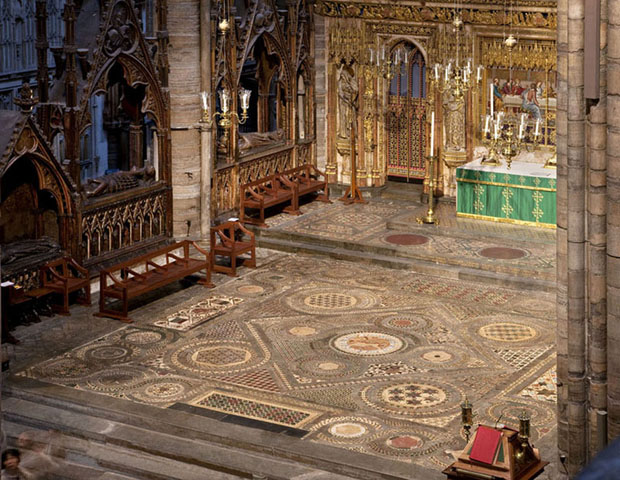
A view of the completed Cosmati pavement from the Muniments room. Courtesy of Westminster Abbey.
When Prince William and Kate Middleton marry this Friday at Westminster Abbey in front of 3,000 guests, including royals and heads of state from around the world, they will be standing on hallowed ground, literally—a historic glittering pavement featuring small shapes of colored stones and glass inlaid into a stone base in intricate, geometric patterns laid down in 1268 by order of Henry III.
The Cosmati Pavement, the medieval tile mosaic floor in front of the Abbey’s High Altar where Prince William and Middleton are expected to take their vows, has in the past been rarely visible due to its age and condition, but the floor has been newly conserved thanks in large part to a grant from the Getty Foundation.
The floor has both artistic and historic significance. Named after a Roman family of skilled architects, craftsmen, and mosaic workers, Cosmati work was fashionable in the 12th and 13th centuries. This unusual mosaic technique was used to decorate tombs, pavements, and furniture in churches throughout Italy, and the style was employed at Westminster Abbey for the flooring upon which the royal coronation takes place. Thirty-eight kings and queens have been crowned standing upon the Cosmati Pavement. The floor in the Abbey is one of the last few existing in situ mosaic examples left in England. According to Westminster Abbey, the complexity and subtlety of the design and workmanship can be seen nowhere else on such a large scale.
Prior to the recent restoration, the pavement was so seriously deteriorated it was only able to be used when covered over. The conservation project funded by the Getty focused on stabilizing the floor so the protective covering is able to be removed more frequently, allowing more visitors to view the wonderful mosaic work.

The Cosmati pavement after cleaning and conservation. Courtesy of Westminster Abbey.
The design work on the pavement is stunning. At 24 feet and 10 inches square, the mosaic floor is quite large and consists of geometric patterns created from pieces of stone of different colors and sizes cut into a wide variety of shapes including triangles, squares, circles, and rectangles. The central roundel is made of onyx, and the pavement also includes purple porphyry, green serpentine, and yellow limestone, alongside pieces of opaque colored glass—red, turquoise, cobalt blue and bluish white. Unusual for the era, the work lies in a bed of dark limestone known as Purbeck marble—white was normally used for this kind of work in Italy.
The design itself has a broad border, with a rectangle in the middle of each side and five roundels between each rectangle. No two roundels are the same. In detail, the variations of the pattern are virtually endless.
Interestingly, the three inscriptions found on the pavement, formed of brass letters, refer to the end of the world, calculating it will last for 19,683 years.
In addition to stabilizing the mosaic, conservators also cleaned the pavement, consolidated and repaired damaged glass, stone, and mortar elements, and reapplied a protective coating. All of the work has been carefully documented by the Abbey in an effort to guide future conservation efforts.

Conservators used a poultice solvent cleaning method on the pavement, using paper pulp and Shellsol T. Courtesy of Westminster Abbey.

Conservators consolidating the Purbeck marble tracery within one of the original remaining roundels. Courtesy of Westminster Abbey.
Another interesting aspect of the conservation work funded by the Getty is that it served as an important learning opportunity. Throughout the project, undergraduate and graduate students from the Conservation Studies program at the City and Guilds of London Art School were able to work alongside the conservators, mason, and archivist to gain hands-on experience with cleaning, repair, and research as part of their work experience. The site also is being made available to universities for scientific research.

The first coat of microcrystalline wax being applied to the surface of the pavement. Courtesy of Westminster Abbey.
The public benefits as well—regular lectures are now being given by the Abbey staff to visitors about the remarkable craftsmanship of this very special pavement. And come Friday, when Prince William and Kate Middleton marry, the historic floor will be unveiled to admiring viewers from all over the world.
As a side note, this isn’t the first time the Getty Foundation has given a grant to restore important artwork at Westminster Abbey. The Foundation also gave a grant in 1996, which ended in 2005, to support the conservation of the Westminster Abbey Retable, a 13th-century panel painting in the Abbey’s collection.




Having noticed the pavement specifically while watching the wedding, I enjoyed reading this post afterward. The floor is beautiful, and surely does make an ideal wedding gift for the couple who has everything, and for every visitor to the Abbey.
Lovely article – amazing project. I have one question ….the article describes the mosaic as being 24 feet by 10 INCHES square – did you mean 10 feet? If not, I’m confused.
Not at all confusing! Each side of the square is 24 feet 10 inches long; it is 24 feet 10 inches square
Oh, never mind — I figured out what you meant. 24 feet AND 10 inches BY 24’10”. Got it.
such a beautiful piece and and an excellent art work done professionally.
Congratulations! what a remarcable work! Thank you, getty foundation for taking care of this unexpected medieval mosaic.